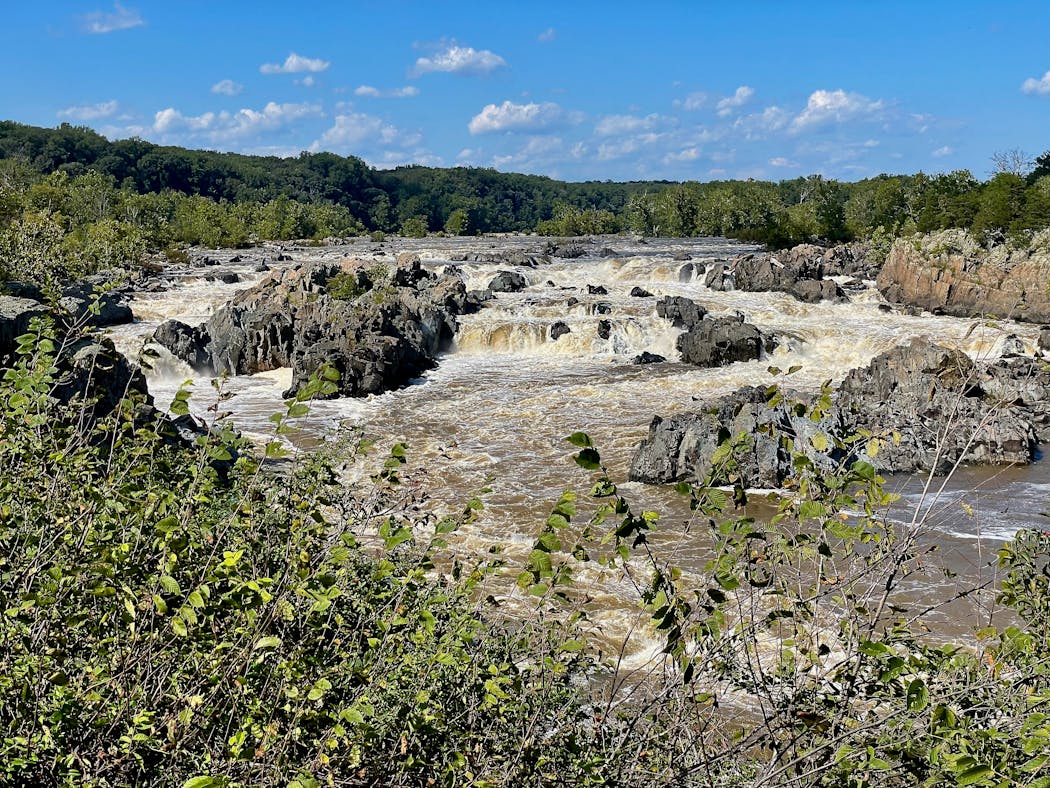A fast-moving stream lay a few paces ahead of me, hurtling over a precipice and into the Potomac River far below. The blue trail markers I'd been following all morning led me here, but now I couldn't figure out how to cross the stream or get down to the river.
Suddenly three heads popped up from a hidden crevasse. The trio of anglers told me there was a path down to the water — but it was a challenging, rocky scramble. With that, they slipped into the woods, and I began carefully picking my way down the crevasse, with only a crude metal railing to steady me.
Minutes later, I was lunching next to the river on a sun-warmed rock, marveling at all of the experiences I'd had so far on the Potomac Heritage Trail, a major American pathway that few know exists.
The Potomac Heritage Trail, or PHT, is one of America's 11 National Scenic Trails, a prestigious designation shared by the famed Appalachian and Pacific Crest trails. While the PHT's sister paths are single point-to-point trails, the 750-mile-plus PHT network meanders in various directions as its winds along "The Nation's River." And while the other National Scenic Trails are mainly for hiking and backpacking, sections of the PHT are open to cyclists, equestrians and mountain bikers. You can even paddle some portions.
"Few trails offer the diversity found on the PHT," said Anne O'Neill, trail coordinator for the National Park Service. "It showcases the history and natural beauty of the Potomac, and it's the only National Scenic Trail so close to an urban environment." Indeed, on its journey from Chesapeake Bay to the Allegheny Mountains, the PHT snakes through Washington, D.C., and the entire metropolitan area.
National history
Several weeks earlier, I'd set out to hike the entire trail in an epic, 42-day trek. In its southeastern reaches, I walked along both sides of the Potomac from its mouth on the Chesapeake. On the Virginia side, I passed George Washington Birthplace National Monument; in Maryland, the trail wound through Historic St. Mary's City, a living history museum and site of Maryland's first capital.
Reaching D.C., the path leaves the Potomac to join the Civil War Defenses of Washington Trail. Also known as the Circle Forts Trail, this route led me through the streets and parks of the capital to see where some of the Union Army's 68 forts and 93 batteries once stood. Erected to protect the capital from invasion by the Confederate Army, original earthworks are still visible.
Back in Virginia, the trail let me explore Mount Vernon (Washington's home), Prince William Forest Park (the largest protected natural area in the D.C. metro) and the spacious, leafy grounds of the Marine Corps Base Quantico. Later I tackled a rugged stretch linking D.C. to Ball's Bluff, site of an early Civil War battle. It's on this section that I conquered the crevasse and, more pleasantly, Great Falls Park, where the Potomac drops some 60 feet in a stunning, multi-tiered waterfall.
Roughly halfway through my journey, I hopped back across the river to the Maryland side, where the PHT piggybacks on the 184.5-mile C&O Canal Towpath. Originally used by mules to tow boats through canals adjacent to the river, today the gravel path is a favorite among cyclists. Campsites dot the trail, and you can check out the remnants of dozens of lift locks, lockhouses and aqueducts.
Even better, you can book a stay at seven original lockhouses refurbished to various time periods. After my first day on the C&O, I eschewed a campsite in favor of a stay at Swains, a spacious lockhouse renovated to interpret life in 1916, when lock tenders were on call day and night in return for a meager monthly salary, a home and an acre of land.
Into the highlands
I crossed the Appalachian Trail at Harper's Ferry, W.Va., then passed the remains of the Round Top Cement Mill, which once produced cement for the U.S. Capitol and the Washington Monument. One night, a kayaker sharing my campsite showed me how to open and eat a pawpaw, a creamy, mild-flavored fruit that grows on the plentiful pawpaw trees lining the path.
In Cumberland, Md., the trail connects with the Great Allegheny Passage, or GAP, a 150-mile rail trail to Pittsburgh. I struck out on the GAP, also popular with cyclists, then segued onto a challenging loop along the Eastern Continental Divide. I was rewarded for my hard work when I camped at the Meadow Mountain overlook, waking to a killer sunrise.
Back on the GAP, I ambled through old railroad tunnels, crossed the Mason-Dixon Line, and watched three otters tumble across the path on their way to the nearby Youghiogheny River. When I reached Ohiopyle, a Pennsylvania tourist town, it was time for the final stretch: the Laurel Highlands.
For four days I climbed up and down sometimes tortuous terrain, wound through massive rock formations and drank in beautiful vistas. At night, I camped in old Adirondack-style shelters that once graced the Appalachian Trail.
Then, suddenly, I was finished. Unfortunately, there was no trailhead sign where I could pose for a final photo, possibly because this trail meanders in so many directions. So instead, I climbed atop a bench stamped "Laurel Highlands Hiking Trail."
The Park Service's O'Neill told me I may have been the first person to have thru-hiked the entire 750-mile present-day route of the PHT. If so, I can claim a little piece of Potomac River history, too.
Potomac Heritage National Scenic Trail
Website: nps.gov/pohe.
Melanie Radzicki McManus wrote about thru-hiking the Superior Hiking Trail for the Star Tribune in 2018. She lives near Madison, Wis.




